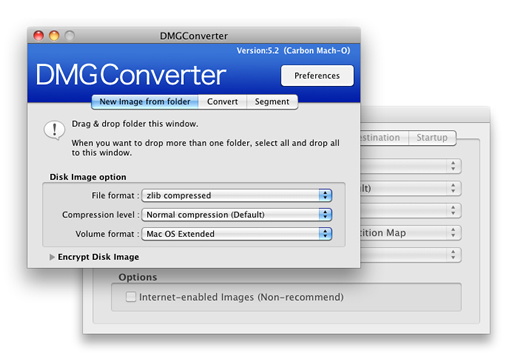

This means that creating a cross-platform ISO9660/HFS+ hybrid has a minimal overhead when compared to a single filesystem image." Hizzaa!ĭMG Converter () can create ISO filesystems, but it cannot CONVERT images to ISO filesystems, only make new images using it. The data area of the image is shared between all filesystems, and only directory information and volume meta-data are unique to each filesystem. "By default, if no filesystem is specified, the image will be created with all four filesystems as a hybrid image. But look at the "makehybrid" verb after the 4 filesystems (-hfs, -iso, -joliet, -udf) under "makehybrid" is this: The "convert" verb is basically all the Disk Utility functionality, but in the Terminal. Look at "convert", then look at "makehybrid". Hit Space or Return until you get down to the VERBS section. To see the 411 on this, type "man hdiutil" in the Terminal. And can even be a hard-drive! Heck, for all I know can be a very large database file by itself. Just get the path correct (does not have to be ~/Desktop if you want to make an image from a folder elsewhere, or a disc image elsewhere) and "viola" - you get a perfect hybrid disc image file useable in virtually *every* modern OS. The currently logged-in user likely does NOT have a ~/desktop, but DOES have a ~/Desktop directory.īut wait - it gets better! can be the name of a FOLDER! It does not have to be a. The correct filename extension will be added only if it isn't part of the provided name. You can rename later, so don't dork it up - leave out spaces, symbols, etc. That's it! The "example.dmg" which you dragged to your Desktop is, and is just any name for the resulting image file.

Hdiutil makehybrid -o ~/Desktop/ ~/Desktop/
#Convert .dmg to .iso windows
dmg file (the CD, DVD or volume of which you want to use in Windows or Linux) to your Desktop. But what if you could have HFS+, ISO-9660, Joliet, *and* UDF all on the same image - and have it be smaller than the file created by the above Terminal commands? Well, you easily can - here's the quick and dirty how-to:ġ. But the resulting burned CD has only 1 filesystem - HFS+ (Mac OS Extended) that is not very useful in other OSes.īut for Windows compatibility (a CD or volume you can actually mount) you want the ISO-9660 *filesystem*, with or without the "Joliet extensions" to the ISO specification. dmg and pick Convert in Disk Utility) and rename the. cdr ("CD/DVD Master") from Disk Utility in the first place (or select a. Hdiutil convert -format UDTO -o /path/to/outfile /path/to/source.dmg

Hdiutil convert /path/to/filename.dmg -format UDTO -o /path/to/savefile.iso cdr image, is then burnable in Windows) and the actual ISO-9660 *filesystem*, with or without the Joliet extensions, which is an actual burnable, mountable and useable VOLUME in Windows. I think there is some confusion between naming something ".iso" (which, if a.


 0 kommentar(er)
0 kommentar(er)
